In the modern world, power electronics PDF plays a pivotal role in shaping various technological advancements that we rely on daily. From renewable energy systems to consumer electronics, power electronics PDF is the driving force behind efficient energy conversion and control. This article aims to provide a comprehensive guide to power electronics PDF, delving into its key concepts, applications, and significance in various industries.
Detail of Power Electronics PDF
| PDF Title | Power Electronics PDF |
|---|---|
| No of Pages | 715 |
| Author | MUHAMMAD H. RASHID |
| Category | Academic & Education |
| Language | English |
| Buy on Latest Edition |
Challenge and Thrill of Pre-College Mathematics PDF
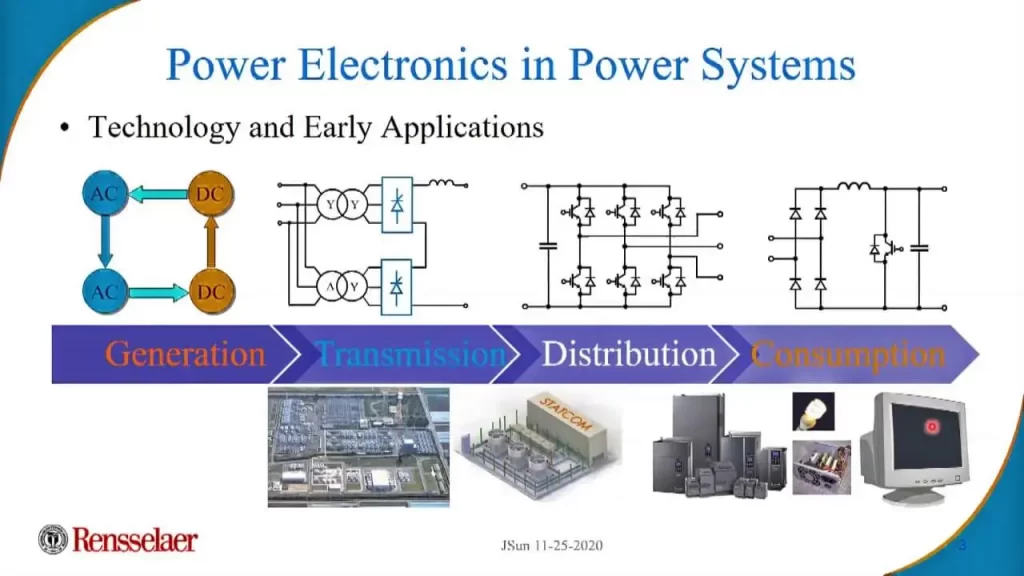
Table of Contents
Introduction to Power Electronics PDF | What is Power Electronics
Power electronics is a specialized field that deals with the conversion, control, and management of electrical power. It involves the use of semiconductor devices to efficiently control and manipulate electric power for various applications.
Basics of Power Semiconductor Devices
Power semiconductor devices such as diodes, transistors, and thyristors form the building blocks of power electronics. Understanding their characteristics and behaviors is crucial for designing efficient power circuits.
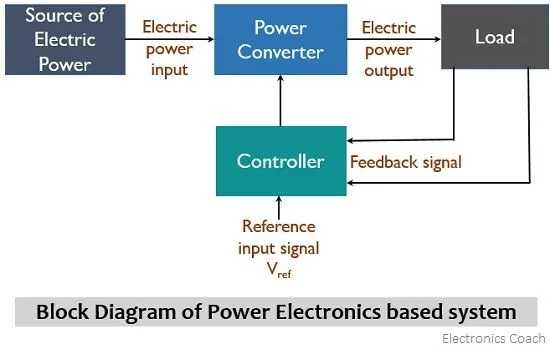
Switching Principles and PWM Techniques
Switching is a fundamental concept in power electronics, enabling the control of power flow. Pulse Width Modulation (PWM) techniques are commonly used to regulate the output voltage of power converters.
DC-DC Converters: From Buck to Boost
DC-DC converters are essential for adjusting voltage levels according to the requirements of a system. Buck, boost, and buck-boost converters are widely used for voltage step-down and step-up operations.
AC-DC Converters and Rectification
AC-DC converters, also known as rectifiers, are crucial for converting alternating current (AC) into direct current (DC). Full-wave and half-wave rectifiers are commonly employed in various applications.
Inverters: AC-AC Voltage Conversion
Inverters are employed to convert DC back to AC, enabling the use of DC sources in AC-powered devices. They find applications in renewable energy systems, motor drives, and uninterruptible power supplies.
Applications in Renewable Energy
Power electronics plays a pivotal role in harnessing energy from renewable sources like solar panels and wind turbines. It ensures efficient power extraction and grid integration.
Power Electronics in Motor Drives
Motor drives utilize power electronics to control the speed and torque of electric motors. Variable frequency drives (VFDs) are used in industrial, automotive, and consumer applications.
Power Management in Consumer Electronics
Consumer electronic devices such as laptops and smartphones rely on power electronics for efficient battery charging and power management.
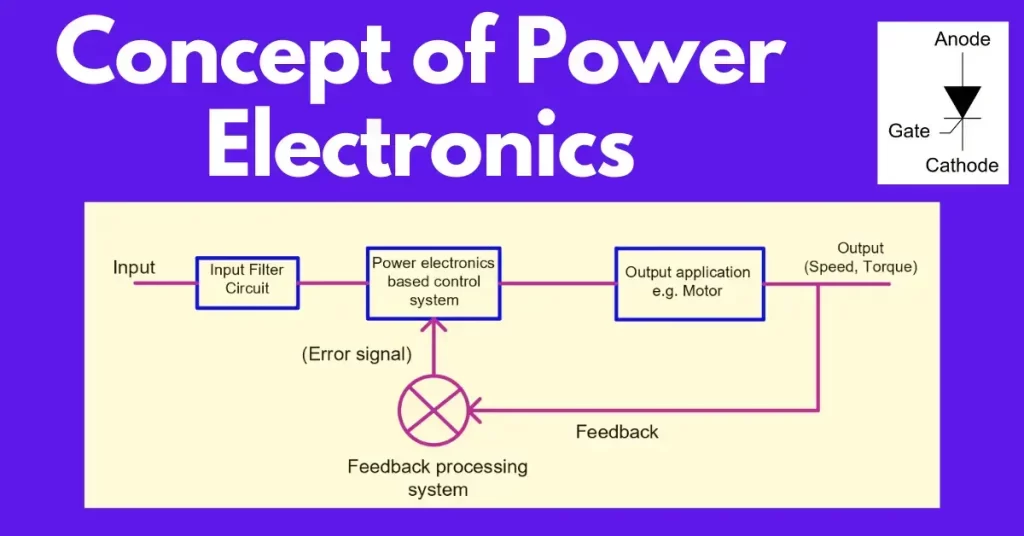
Industrial Applications and Power Supplies
Industries heavily depend on power electronics for precise control of industrial processes and equipment. Uninterruptible power supplies (UPS) ensure continuous operation during power outages.
Importance of Efficiency and Thermal Management
Efficiency is a critical consideration in power electronics, as any energy loss translates to reduced system performance. Effective thermal management is essential to prevent overheating of components.
Emerging Trends in Power Electronics
Advancements in wide-bandgap semiconductors, digital control techniques, and wireless power transfer are shaping the future of power electronics.
Challenges and Future Prospects
While power electronics offers immense potential, challenges such as electromagnetic interference and complex control algorithms need to be addressed for widespread adoption.
Advantages and Disadvantages of Power Electronics
Power electronics provides efficient energy conversion, but it also introduces complexities in terms of design, control, and electromagnetic compatibility.
Conclusion by Power Electronics PDF
In conclusion, power electronics is the cornerstone of modern technology, enabling efficient energy conversion and control in various applications. Its continuous evolution drives innovation across industries, from renewable energy to consumer electronics.
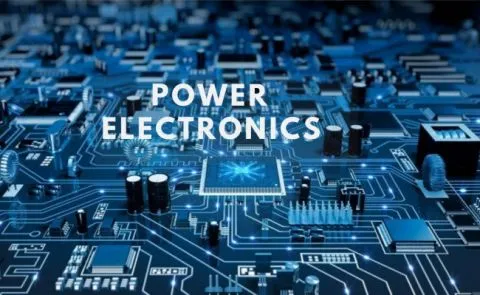
Power Electronics Interview Questions | Power Electronics MCQ
Q1: What is power electronics? A1: Power electronics is a field of engineering that deals with the conversion, control, and management of electrical energy.
Q2: What are some common applications of power electronics? A2: Power electronics is used in applications such as renewable energy systems, motor drives, electric vehicles, industrial machinery, consumer electronics, and more.
Q3: What is the main objective of power electronics? A3: The main objective of power electronics is to efficiently convert and control electrical power to meet specific system requirements.
Q4: What is a power semiconductor device? A4: Power semiconductor devices are electronic components designed to handle high levels of electrical power. Examples include diodes, thyristors, MOSFETs, and IGBTs.
Q5: How does a diode function in power electronics? A5: A diode allows current to flow in one direction only and is often used as a rectifier to convert alternating current (AC) to direct current (DC).
Q6: What is a rectifier? A6: A rectifier is a circuit or device that converts AC to DC by allowing current to flow in one direction only.
Q7: What is a thyristor? A7: A thyristor is a semiconductor device that acts as a switch and is commonly used in applications requiring high voltage and current handling.
Q8: What is pulse width modulation (PWM)? A8: PWM is a technique used to control the average voltage applied to a load by rapidly switching a power semiconductor device on and off.
Q9: How is PWM used in power electronics? A9: PWM is used to control the speed of motor drives, regulate the output of power supplies, and manage the power delivered to loads.
Q10: What is an inverter in power electronics? A10: An inverter is a device that converts DC power to AC power, often used in applications like motor drives and renewable energy systems.
Q11: Explain the concept of voltage source inverter (VSI). A11: A voltage source inverter is an inverter that maintains a constant voltage magnitude on its output terminals while varying the frequency and phase of the AC output.
Q12: What is an IGBT? A12: An IGBT (Insulated Gate Bipolar Transistor) is a high-power semiconductor device that combines the advantages of MOSFETs and bipolar transistors.
Q13: How does an IGBT work? A13: An IGBT operates by controlling the flow of current between its collector and emitter using a gate signal.
Q14: What is a chopper circuit? A14: A chopper circuit is a type of DC-DC converter that switches the input voltage on and off to regulate the output voltage.
Q15: What are motor drives? A15: Motor drives are power electronics systems that control the speed, torque, and direction of electric motors.
Q16: How does power electronics contribute to energy efficiency? A16: Power electronics enables efficient conversion and control of power, reducing energy losses and improving overall system efficiency.
Q17: What role does power electronics play in renewable energy systems? A17: Power electronics is used to interface renewable energy sources like solar panels and wind turbines with the grid by converting the generated power to the appropriate voltage and frequency.
Q18: Explain regenerative braking in electric vehicles using power electronics. A18: Power electronics in electric vehicles can reverse the operation of the motor during braking, converting the kinetic energy of the vehicle back into electrical energy that can be stored in the battery.
Q19: What is a DC-DC converter? A19: A DC-DC converter is a power electronics device that converts one DC voltage level to another, either step-up or step-down.
Q20: Describe the concept of soft switching in power electronics. A20: Soft switching techniques reduce the switching losses in power semiconductor devices by ensuring that the device turns on or off when the voltage or current is near zero.
Q21: How does power factor correction improve the efficiency of power systems? A21: Power factor correction techniques minimize reactive power, which in turn reduces energy losses and improves the efficiency of power distribution systems.
Q22: What is the role of power electronics in uninterruptible power supplies (UPS)? A22: Power electronics in UPS systems provide backup power during mains power failures, ensuring uninterrupted power supply to critical loads.
Q23: What is a resonant converter? A23: A resonant converter is a type of power electronics circuit that operates at a resonant frequency, reducing switching losses and improving efficiency.
Q24: Explain the concept of electric motor control using power electronics. A24: Power electronics control the voltage and frequency applied to electric motors, enabling precise control of motor speed and torque.
Q25: What are the advantages of using power electronics in adjustable-speed drives? A25: Power electronics-based adjustable-speed drives offer better energy efficiency, reduced maintenance, improved process control, and smoother operation compared to fixed-speed drives.
Q26: How does power electronics impact the electric grid? A26: Power electronics devices regulate power flow, maintain grid stability, and facilitate the integration of distributed energy resources.
Q27: Discuss the significance of isolated gate drivers in power electronics. A27: Isolated gate drivers provide electrical isolation between control signals and high-power switching devices, enhancing safety and reliability.
Q28: What is a cycloconverter? A28: A cycloconverter is a power electronics device that converts AC power at one frequency to AC power at a lower or higher frequency.
Q29: How does power electronics contribute to reducing harmonic distortion in power systems? A29: Power electronics devices can control the shape of the current waveform, reducing harmonic distortion and improving the quality of power in the system.
Q30: What are the challenges in thermal management of power electronics devices? A30: Power electronics devices generate heat during operation, and managing this heat is crucial to prevent device failure and ensure long-term reliability.
Q31: Explain the concept of voltage sag and how power electronics can mitigate it. A31: Voltage sag is a short-term drop in voltage levels. Power electronics can provide rapid voltage support by injecting compensating voltage to mitigate the sag.
Q32: How does power electronics enable grid-connected photovoltaic systems? A32: Power electronics converters interface solar panels with the grid, converting the DC power generated by the panels to AC power compatible with the grid.
Q33: What is a flyback converter? A33: A flyback converter is a type of isolated DC-DC converter that stores energy in an inductor during the on-time of the switching device and releases it during the off-time.
Q34: How does power electronics impact energy storage systems? A34: Power electronics manage the charging and discharging of energy storage systems, ensuring efficient energy utilization and grid integration.
Q35: Explain the concept of active power filtering using power electronics. A35: Active power filters use power electronics to inject compensating currents into the system, canceling out harmonic currents and improving power quality.
Q36: What is the role of power electronics in high-voltage direct current (HVDC) transmission? A36: Power electronics converters are used in HVDC systems to convert AC power to DC for efficient long-distance transmission and vice versa.
Q37: How does power electronics contribute to smart grid technology? A37: Power electronics enable bidirectional power flow, voltage control, and rapid response capabilities, making them essential for the implementation of smart grid features.
Q38: What is a gate driver circuit? A38: A gate driver circuit is a component that generates the necessary voltage and current signals to control the switching of power semiconductor devices.
Q39: Describe the concept of zero-voltage switching (ZVS) and its significance. A39: Zero-voltage switching occurs when a power semiconductor device is switched on or off when the voltage across it is zero, reducing switching losses and improving efficiency.
Q40: How does power electronics impact data centers? A40: Power electronics systems manage power distribution, backup power, and cooling systems in data centers, optimizing energy efficiency and reliability.
Q41: What is a phase-locked loop (PLL) and its role in power electronics? A41: A PLL is a control system that synchronizes the frequency and phase of an output signal with a reference signal, ensuring stable operation in applications like grid-connected inverters.
Q42: Explain the concept of active rectification and its advantages. A42: Active rectification uses power electronics to control the rectification process, reducing voltage drops and losses in rectifier circuits.
Q43: What is a bidirectional DC-DC converter? A43: A bidirectional DC-DC converter can transfer power in both directions, making it suitable for applications like energy storage systems and electric vehicles.
Q44: How does power electronics contribute to electric railway systems? A44: Power electronics control the traction and braking systems in electric trains, providing efficient speed control and energy regeneration during braking.
Q45: Discuss the role of power electronics in frequency converters for induction heating. A45: Power electronics frequency converters control the frequency of the AC power supplied to induction heating systems, enabling precise control of heating processes.
Q46: What is a matrix converter? A46: A matrix converter is a power electronics device that directly converts AC power from one frequency to another without using intermediate DC conversion.
Q47: How does power electronics enable energy-efficient lighting systems? A47: Power electronics is used to control the intensity and color of LED lighting systems, resulting in energy savings and enhanced lighting quality.
Q48: Explain the concept of multi-level inverters and their advantages. A48: Multi-level inverters use multiple voltage levels to generate a stepped AC waveform, reducing harmonic content and improving the quality of the output waveform.
Q49: What are the challenges in electromagnetic interference (EMI) mitigation in power electronics systems? A49: Power electronics systems can generate EMI due to switching operations. Proper layout design, shielding, and filtering techniques are used to mitigate EMI.
Q50: How do wide bandgap (WBG) semiconductors impact power electronics technology? A50: Wide bandgap semiconductors like SiC and GaN offer higher switching speeds, higher temperature operation, and lower conduction losses, leading to more efficient and compact power electronics systems.
Q51: What is the concept of virtual inertia in power systems, and how does power electronics contribute to it? A51: Virtual inertia is the ability to emulate the stabilizing effect of physical inertia in power systems. Power electronics systems can provide virtual inertia by controlling the rate of change of power output, aiding grid stability during disturbances.
Q52: How does power electronics enhance the efficiency of electric vehicle battery charging? A52: Power electronics control the charging process, adjusting voltage and current levels to optimize charging speed while preventing overloading and extending battery life.
Q53: Explain the importance of snubber circuits in power electronics. A53: Snubber circuits are used to suppress voltage spikes and reduce switching losses in power electronics devices, enhancing their reliability and efficiency.
Q54: What is a DC link capacitor, and why is it crucial in power electronics systems? A54: A DC link capacitor stores energy and smoothens voltage fluctuations in DC bus systems, ensuring stable operation and reducing ripple in output waveforms.
Q55: How does power electronics contribute to energy-efficient HVAC (heating, ventilation, and air conditioning) systems? A55: Power electronics control the operation of compressors, fans, and pumps in HVAC systems, enabling variable-speed operation and energy savings.
Q56: Discuss the challenges of electromagnetic compatibility (EMC) in power electronics. A56: Power electronics systems can emit electromagnetic interference (EMI) and are susceptible to external interference. EMC practices are employed to ensure proper functioning without disruption.
Q57: How do power electronics play a role in load shedding and peak shaving? A57: Power electronics systems can be used to intelligently shed non-essential loads during peak demand periods, reducing strain on the grid and minimizing energy costs.
Q58: Explain the concept of fault-tolerant power electronics systems. A58: Fault-tolerant power electronics systems are designed to continue functioning in the presence of faults or failures, improving system reliability and reducing downtime.
Q59: What is a gate turn-off thyristor (GTO), and where is it commonly used? A59: A GTO is a thyristor that can be turned off by applying a gate signal. It’s used in high-power applications such as motor drives and HVDC systems.
Q60: How do power electronics contribute to grid stabilization during the integration of renewable energy sources? A60: Power electronics devices can provide reactive power support and voltage control, helping to stabilize the grid as the intermittent output of renewable sources fluctuates.
Q61: Explain the concept of modular multilevel converters (MMC) in HVDC systems. A61: MMC is a type of voltage source converter that uses multiple sub-modules to achieve high-voltage conversion with reduced harmonic content and improved efficiency.
Q62: How does power electronics contribute to regenerative energy capture in elevators? A62: Power electronics systems capture and convert the energy generated during elevator descent, feeding it back to the grid or using it for other building loads.
Q63: Discuss the role of power electronics in electric grid resilience and recovery after disturbances. A63: Power electronics devices enable rapid control and reconfiguration of grid components, helping to restore power and stability more efficiently after disruptions.
Q64: What is an active front-end converter, and where is it commonly used? A64: An active front-end converter is used to control the flow of power between the grid and variable-speed motor drives, enhancing power quality and reducing harmonic distortion.
Q65: How does power electronics technology impact medical devices? A65: Power electronics control the operation of medical imaging equipment, patient monitoring systems, and other medical devices, ensuring accurate and reliable performance.
Q66: Explain the concept of grid-forming inverters and their significance in standalone microgrids. A66: Grid-forming inverters are capable of autonomously establishing and maintaining stable voltage and frequency in microgrids that are disconnected from the main grid.
Q67: How does power electronics contribute to efficient energy conversion in wind turbines? A67: Power electronics converters adapt the variable frequency AC output from wind turbines to match the grid frequency, allowing efficient power injection into the grid.
Q68: Discuss the challenges of thermal cycling and aging in power electronics systems. A68: Thermal cycling and aging can lead to stress and degradation of power electronics components over time, affecting their reliability and performance.
Q69: What is the role of power electronics in electric power distribution systems? A69: Power electronics devices control voltage levels, manage reactive power, and improve power factor in distribution systems, optimizing energy flow and quality.
Q70: How does power electronics enable the integration of energy storage systems in microgrids? A70: Power electronics manage the bidirectional flow of power between energy storage systems and microgrid components, enhancing grid stability and reliability.
Q71: Explain the concept of soft-start and soft-stop in motor control using power electronics. A71: Soft-start and soft-stop techniques gradually increase or decrease the voltage applied to a motor, reducing mechanical stress and improving equipment lifespan.
Q72: Discuss the role of power electronics in electric propulsion systems for ships. A72: Power electronics control the speed and torque of electric propulsion motors, providing efficient and precise control for marine vessels.
Q73: How does power electronics contribute to energy-efficient lighting dimming systems? A73: Power electronics control the output voltage of lighting systems, enabling smooth dimming and energy savings in both residential and commercial settings.
Q74: Explain the concept of load sharing in parallel-operated power electronics systems. A74: Load sharing ensures that multiple power electronics devices connected in parallel share the load proportionally, enhancing system reliability and performance.
Q75: What is the significance of fault detection and protection schemes in power electronics systems? A75: Fault detection and protection systems prevent catastrophic failures by quickly detecting abnormal conditions and shutting down or isolating faulty components.
Q76: How does power electronics contribute to voltage regulation and stability in microgrids? A76: Power electronics devices can regulate voltage levels, manage reactive power, and ensure stable operation in microgrids with distributed energy resources.
Q77: Discuss the challenges of electromagnetic interference (EMI) filtering in power electronics design. A77: EMI filtering involves mitigating electromagnetic noise generated by power electronics systems to comply with regulatory standards and prevent interference with other electronic devices.
Q78: What is the role of power electronics in resonant wireless power transfer systems? A78: Power electronics are used to control resonant frequencies and manage power transfer efficiency in wireless charging systems for electric vehicles and consumer electronics.
Q79: How does power electronics enable efficient energy conversion in electric trains? A79: Power electronics systems regulate the power supplied to traction motors, enhancing energy efficiency and allowing regenerative braking to recover energy during deceleration.
Q80: Explain the concept of modular power converters and their advantages. A80: Modular power converters consist of smaller, interconnected power electronic modules, providing scalability, redundancy, and ease of maintenance in complex systems.
Q81: How do power electronics contribute to frequency stability and synchronization in power systems? A81: Power electronics devices can control the frequency and phase of generated power, ensuring synchronization with the grid and maintaining stable operation.
Q82: What is a gate commutated thyristor (GCT), and where is it utilized? A82: A GCT is a type of thyristor that can be turned off by a gate signal. It is commonly used in high-voltage applications such as HVDC systems and FACTS devices.
Q83: Discuss the role of power electronics in battery management systems. A83: Power electronics manage the charging, discharging, and balancing of individual cells within a battery pack, extending battery life and optimizing performance.
Q84: How does power electronics contribute to electric heating systems? A84: Power electronics control the power supplied to heating elements, enabling precise temperature control and energy-efficient operation in applications like industrial furnaces.
Q85: Explain the concept of power quality improvement using active filters in power electronics. A85: Active filters inject compensating currents to mitigate harmonic distortion and voltage fluctuations, improving the quality of power in the system.
Q86: How do power electronics enhance the efficiency of photovoltaic (PV) energy conversion? A86: Power electronics converters optimize the voltage and current levels from PV panels to match the grid requirements, maximizing energy extraction and efficiency.
Q87: Discuss the challenges of thermal design and heat dissipation in power electronics systems. A87: Efficient cooling techniques and proper thermal management are essential to prevent overheating and maintain the reliability of power electronics components.
Q88: What is a synchronous rectifier, and why is it used in power electronics systems? A88: A synchronous rectifier replaces diodes in rectifier circuits, reducing voltage drops and power losses by actively controlling the rectification process.
Q89: How do power electronics contribute to grid-connected energy storage for frequency regulation? A89: Power electronics systems quickly respond to grid frequency changes by absorbing or releasing power from energy storage systems, aiding frequency regulation.
Q90: Explain the concept of phase angle control in power electronics. A90: Phase angle control involves adjusting the firing angle of thyristors or other switching devices to control the average voltage applied to a load, thereby regulating power.
Q91: What is the role of power electronics in high-power industrial processes? A91: Power electronics systems control the speed, torque, and efficiency of electric drives in industrial machinery, optimizing manufacturing processes.
Q92: How do power electronics contribute to renewable energy integration in isolated or remote areas? A92: Power electronics systems adapt the output of renewable sources to match local grid conditions, enabling reliable and efficient energy supply in remote locations.
Q93: Discuss the concept of energy harvesting using power electronics. A93: Energy harvesting systems use power electronics to capture and convert ambient energy sources such as solar, vibration, or thermal energy into usable power.
Q94: What is a flywheel energy storage system, and how does power electronics play a role in its operation? A94: A flywheel energy storage system stores kinetic energy and releases it as electrical energy. Power electronics control the charging and discharging process of the flywheel.
Q95: How does power electronics contribute to high-efficiency uninterruptible power supplies (UPS)? A95: Power electronics-based UPS systems provide rapid switchover to battery power during mains power failure, minimizing downtime and ensuring a continuous power supply.
Q96: Explain the concept of voltage-fed full-bridge converters in power electronics. A96: Voltage-fed full-bridge converters convert DC voltage to AC voltage with adjustable frequency and amplitude, commonly used in motor drives and induction heating.
Q97: Discuss the challenges of electromagnetic compatibility (EMC) in power electronics design. A97: Ensuring EMC involves preventing interference between power electronics devices and other electronic systems, maintaining proper operation in a shared environment.
Q98: How do power electronics enable high-efficiency microwave ovens? A98: Power electronics control the power supplied to magnetrons in microwave ovens, providing variable power levels and improving energy efficiency.
Q99: What is the role of power electronics in load leveling and demand response programs? A99: Power electronics can shift load demand by controlling the timing of energy consumption, contributing to load leveling and grid stability.
Q100: Discuss the potential of power electronics in future energy systems and sustainable technologies. A100: Power electronics will play a pivotal role in the integration of renewable energy sources, electric mobility, energy-efficient buildings, and other sustainable technologies, contributing to a cleaner and more resilient energy future.
Q101: Explain the concept of electric grid black start and how power electronics contribute to the restoration process. A101: Black start refers to the ability to restore power to an electric grid after a complete shutdown. Power electronics systems can provide controlled power injection and synchronization to initiate the grid’s recovery.
Q102: How do power electronics devices improve the efficiency of electric vehicle battery charging through fast charging stations? A102: Power electronics systems manage the high-power charging process in electric vehicle fast charging stations, allowing rapid charging while maintaining battery health and grid stability.
Q103: Discuss the role of power electronics in voltage regulation and power factor correction for industrial loads. A103: Power electronics devices adjust the voltage and reactive power to industrial loads, ensuring stable operation, minimizing energy losses, and improving the overall power factor.
Q104: What is the significance of power electronics in HVDC applications for long-distance power transmission? A104: Power electronics converters enable efficient HVDC transmission by converting AC to DC for long-distance transmission, reducing line losses and enabling interconnection of distant grids.
Q105: Explain the concept of soft-switching resonant converters and their advantages in power electronics. A105: Soft-switching resonant converters reduce switching losses by ensuring that the switching transitions occur at zero voltage or current, resulting in higher efficiency and lower electromagnetic interference.
Q106: How does power electronics contribute to dynamic voltage restoration in power distribution systems? A106: Power electronics devices inject compensating voltage to restore voltage levels during momentary voltage sags, ensuring stable operation of sensitive loads.
Q107: Discuss the potential challenges and solutions in mitigating power electronics harmonics in industrial applications. A107: Power electronics harmonics can distort waveforms and cause unwanted effects. Solutions include harmonic filters, active power filters, and proper design practices to reduce harmonic content.
Q108: What is the significance of power electronics in modern aviation systems? A108: Power electronics control the distribution of power in aircraft systems, enabling efficient power conversion and distribution to various components such as avionics and electric actuators.
Q109: Explain the concept of power decoupling in multi-source energy systems using power electronics. A109: Power decoupling involves managing power flow from multiple energy sources to match the load demand while maintaining grid stability, achieved through power electronics control strategies.
Q110: How do power electronics contribute to the efficiency and reliability of electric power steering systems in vehicles? A110: Power electronics control the assistance provided to the steering mechanism, allowing variable assistance levels, improving energy efficiency, and enhancing driver comfort.
Q111: Discuss the challenges and benefits of integrating power electronics into renewable energy-based microgrids. A111: Challenges include system integration and control complexity, but benefits include improved energy management, grid independence, and enhanced resilience in microgrid operations.
Q112: What is the role of power electronics in high-temperature applications such as aerospace and downhole drilling? A112: Power electronics systems designed for high-temperature environments enable efficient energy conversion and control in extreme conditions, enhancing system performance and reliability.
Q113: How does power electronics contribute to electric vehicle-to-grid (V2G) systems? A113: Power electronics enable bidirectional power flow between electric vehicles and the grid, allowing EVs to supply power back to the grid during peak demand periods.
Q114: Explain the concept of multilevel inverters and their advantages in power electronics. A114: Multilevel inverters use multiple voltage levels to approximate a sine wave output, reducing harmonic distortion and enabling higher-voltage output without using high-voltage components.
Q115: How does power electronics technology impact the field of renewable energy forecasting and integration? A115: Power electronics devices enhance the controllability and flexibility of renewable energy systems, making them more predictable and manageable in grid integration.
Q116: Discuss the potential of power electronics in electrifying remote areas with limited access to power infrastructure. A116: Power electronics solutions, along with renewable energy sources and energy storage systems, can provide reliable and sustainable power supply to remote and off-grid communities.
Q117: What is the significance of power electronics in electrically driven water desalination processes? A117: Power electronics control the operation of pumps, motors, and energy-intensive components in water desalination systems, improving energy efficiency and overall process performance.
Q118: Explain the concept of load-side voltage regulation using power electronics. A118: Load-side voltage regulation involves controlling the voltage at the load using power electronics devices to maintain stable operation and prevent voltage fluctuations.
Q119: How does power electronics contribute to the integration of renewable energy sources in agricultural systems? A119: Power electronics systems facilitate the integration of renewable energy sources such as solar panels and wind turbines into agricultural operations, enhancing sustainability and reducing energy costs.
Q120: Discuss the impact of power electronics on electric grid stability during transient and dynamic events. A120: Power electronics devices provide rapid response capabilities, helping to mitigate voltage fluctuations, maintain frequency stability, and enhance grid resilience during dynamic events.
Q121: What is the role of power electronics in active damping of power system oscillations? A121: Power electronics devices can inject damping signals into power systems to counteract oscillations, improving system stability and preventing potential blackouts.
Q122: Explain the concept of load-commutated inverters (LCI) in high-power applications. A122: Load-commutated inverters are used in high-power DC drives and HVDC systems to control power flow and maintain stability while minimizing switching losses.
Q123: How does power electronics enable energy-efficient lighting solutions for smart cities? A123: Power electronics control LED lighting systems, enabling adaptive lighting levels, remote control, and energy-efficient operation in urban environments.
Q124: Discuss the challenges and advancements in thermal interface materials for power electronics cooling. A124: Effective thermal interface materials enhance the transfer of heat between power electronics components and heat sinks, improving thermal management and reliability.
Q125: What is the significance of power electronics in electrically driven propulsion systems for ships and submarines? A125: Power electronics enable efficient and precise control of propulsion motors in naval vessels, contributing to energy savings and maneuverability.
Q126: How do power electronics systems contribute to grid stability in the presence of high penetration of distributed energy resources? A126: Power electronics-based controls can manage voltage fluctuations, regulate reactive power, and ensure a smooth integration of distributed energy resources, maintaining grid stability.
Q127: Discuss the potential challenges and solutions in minimizing electromagnetic interference (EMI) in power electronics systems. A127: Challenges include meeting regulatory EMI standards and preventing interference with nearby electronics. Solutions include proper shielding, grounding, and filtering techniques.
Q128: What is the role of power electronics in high-voltage transmission systems and substation applications? A128: Power electronics systems are used in high-voltage transmission lines and substations to manage power flow, voltage regulation, and improve grid performance.
Q129: Explain the concept of islanding detection and prevention in grid-connected power electronics systems. A129: Islanding detection systems use power electronics to monitor grid conditions and disconnect from the grid when it is detected that an islanded operation is occurring to ensure safety.
Q130: How does power electronics contribute to energy-efficient elevator and escalator systems? A130: Power electronics controls the operation of elevators and escalators, optimizing motor efficiency, reducing energy consumption, and enhancing passenger comfort.
Q131: Discuss the significance of power electronics in space exploration missions. A131: Power electronics systems provide reliable and efficient power conversion for spacecraft, satellites, and rovers, enabling successful communication, data collection, and exploration.
Q132: What is the role of power electronics in improving the efficiency of induction heating processes? A132: Power electronics control the frequency and power supplied to induction heating coils, enabling precise and efficient heating for various industrial applications.
Q133: Explain the concept of energy-efficient data centers and how power electronics technology contributes to their operation. A133: Power electronics technology optimizes power distribution, cooling, and energy management in data centers, reducing energy consumption and improving efficiency.
Q134: How does power electronics technology enhance the efficiency of energy storage systems for electric grids? A134: Power electronics manage the charging and discharging of energy storage systems, improving their efficiency and enabling grid services such as peak shaving and frequency regulation.
Q135: Discuss the role of power electronics in advanced lighting control systems for buildings. A135: Power electronics controls dimming, color temperature, and energy-efficient lighting schemes in smart lighting systems for commercial and residential buildings.
Q136: Explain the concept of soft-switching techniques and their applications in power electronics. A136: Soft-switching techniques, such as zero-voltage switching (ZVS) and zero-current switching (ZCS), minimize switching losses, reduce stress on components, and improve efficiency in power electronics circuits.
Q137: How does power electronics contribute to the development of energy-efficient appliances? A137: Power electronics control the operation of appliances such as refrigerators, air conditioners, and washing machines, optimizing energy consumption and enhancing user experience.
Q138: Discuss the potential of power electronics in the electrification of public transportation systems. A138: Power electronics technology enables the efficient operation of electric buses, trams, and trains, reducing emissions and improving urban transportation systems.
Q139: What is the role of power electronics in wind turbine pitch control systems? A139: Power electronics systems control the angle of wind turbine blades, optimizing power extraction by adjusting blade pitch in response to wind conditions.
Q140: How do power electronics contribute to the stability of interconnected power grids? A140: Power electronics devices enhance grid stability by providing rapid voltage control, reactive power compensation, and frequency regulation in interconnected power systems.
Q141: Explain the concept of soft-start and soft-stop in motor control using power electronics. A141: Soft-start and soft-stop gradually ramp up or down the voltage supplied to motors, reducing mechanical stress, current surges, and wear on equipment.
Q142: Discuss the challenges and advancements in thermal management of power electronics systems. A142: Challenges include dissipating heat efficiently from high-power components. Advancements include advanced cooling techniques, heat sinks, and thermal simulation tools.
Q143: What is the significance of power electronics in electrifying public transportation systems like electric trains and trolleybuses? A143: Power electronics technology is crucial for controlling traction motors, optimizing energy consumption, and regenerative braking in electric transportation systems.
Q144: Explain the concept of voltage-source converters (VSC) in high-voltage direct current (HVDC) transmission. A144: VSCs are power electronics converters that convert DC voltage to AC voltage with variable frequency and amplitude, used in HVDC systems for efficient long-distance power transmission.
Q145: How do power electronics contribute to the stability and efficiency of microgrid operations? A145: Power electronics devices control the power flow between distributed energy resources, energy storage systems, and loads, ensuring stability and efficient energy management in microgrids.
Q146: Discuss the potential challenges and solutions in power electronics reliability and fault tolerance. A146: Challenges include component degradation and unexpected failures. Solutions involve redundant designs, fault detection systems, and improved thermal management.
Q147: What is the role of power electronics in energy-efficient heating, ventilation, and air conditioning (HVAC) systems? A147: Power electronics controls HVAC components like fans, compressors, and pumps, optimizing energy usage, enhancing comfort, and improving overall system efficiency.
Q148: Explain the concept of load sharing and power management in paralleled power electronics systems. A148: Load sharing involves distributing power among paralleled devices to ensure balanced operation. Power management optimizes power flow based on load conditions and priorities.
Q149: How does power electronics technology contribute to the development of smart appliances and home automation systems? A149: Power electronics enable precise control of energy consumption in smart appliances, allowing users to remotely monitor and adjust settings for energy efficiency.
Q150: Discuss the potential applications of power electronics in the aerospace industry beyond propulsion systems. A150: Power electronics technology is used in avionics, power distribution, lighting, communication, and other systems within aircraft, enhancing efficiency and reliability.
Q151: Explain the concept of power electronics-based energy harvesting systems and their potential applications. A151: Power electronics-enabled energy harvesting systems capture ambient energy sources like solar, vibration, and thermal energy, converting them into usable power for wireless sensors, wearables, and remote devices.
Q152: How do power electronics contribute to the efficiency and reliability of photovoltaic (PV) inverter systems? A152: Power electronics inverters convert DC power from solar panels into AC power for the grid, optimizing energy extraction and ensuring reliable grid integration.
Q153: Discuss the role of power electronics in reducing energy consumption and improving efficiency in industrial motor drives. A153: Power electronics control the speed and torque of industrial motor drives, minimizing energy losses, improving process control, and enhancing energy efficiency.
Q154: What is the importance of power electronics in achieving grid-connected energy storage for load leveling and demand response? A154: Power electronics-based energy storage systems enable seamless integration of renewable energy and provide grid support services, contributing to load leveling and demand response programs.
Q155: Explain the concept of energy regeneration using power electronics in electric transportation systems. A155: Energy regeneration involves converting the kinetic energy during braking into electrical energy, which is then stored or fed back into the grid using power electronics systems.
Q156: How does power electronics technology enhance the efficiency and reliability of traction systems in high-speed trains? A156: Power electronics control the traction motors, allowing variable speed control, efficient energy utilization, and regenerative braking in high-speed train systems.
Q157: Discuss the potential of power electronics in advancing renewable energy technologies beyond solar and wind, such as ocean energy and geothermal. A157: Power electronics can adapt to various renewable energy sources like ocean waves, tides, and geothermal heat, converting their energy into usable power for diverse applications.
Q158: What is the significance of power electronics in grid stability and power quality improvement in developing countries? A158: Power electronics solutions can address voltage fluctuations, harmonics, and power factor issues, contributing to improved power quality and grid stability in developing regions.
Q159: Explain the concept of energy storage systems coupled with power electronics for enhancing microgrid resilience. A159: Power electronics manage the charging and discharging of energy storage systems in microgrids, ensuring a reliable power supply during disruptions and enhancing overall system resilience.
Q160: How does power electronics technology contribute to improving energy efficiency in HVAC systems for large commercial buildings? A160: Power electronics controls HVAC components and systems in large buildings, allowing optimized energy consumption, temperature control, and demand management.
Q161: Discuss the potential applications of power electronics in medical implantable devices. A161: Power electronics are used in medical implantable devices such as pacemakers and neurostimulators to efficiently convert and regulate power, extending the life of the device and reducing the need for frequent replacements.
Q162: Explain the role of power electronics in high-power industrial welding and cutting processes. A162: Power electronics systems control the output current and voltage in industrial welding and cutting machines, ensuring precise energy delivery for efficient and high-quality welding operations.
Q163: How do power electronics contribute to achieving dynamic voltage stability in power systems? A163: Power electronics-based voltage regulators can rapidly adjust the voltage levels in power systems, maintaining stability and preventing voltage collapse during transient events.
Q164: Discuss the challenges and advancements in power electronics packaging and miniaturization. A164: Challenges include heat dissipation and component integration. Advancements include advanced materials, 3D integration, and compact packaging techniques.
Q165: What is the role of power electronics in grid modernization and the integration of distributed energy resources? A165: Power electronics enable the integration of renewable energy sources, energy storage, and demand response programs into the grid, supporting grid modernization and increased energy efficiency.
Q166: Explain the concept of power electronics-enabled fault ride-through (FRT) capability in wind turbine systems. A166: FRT capability allows wind turbines to remain connected to the grid and maintain operation during voltage dips or faults, enhancing grid stability and reliability.
Q167: How does power electronics contribute to the development of smart grid communication and control systems? A167: Power electronics devices can provide remote monitoring, control, and communication capabilities, enabling efficient data exchange and real-time grid management in smart grid systems.
Q168: Discuss the role of power electronics in energy-efficient electric water heating systems. A168: Power electronics controls electric water heaters, ensuring gradual heating and efficient energy consumption based on user demand and thermal requirements.
Q169: What is the significance of power electronics in the electrification of public transportation systems like electric buses and trams? A169: Power electronics enable the efficient operation of electric buses and trams, improving energy consumption, reducing emissions, and enhancing urban mobility.
Q170: Explain the concept of power electronics-based energy management systems for industrial complexes. A170: Energy management systems using power electronics optimize energy consumption, load scheduling, and demand response in industrial facilities, minimizing energy costs and enhancing efficiency.
Q171: Discuss the potential of power electronics in electrically powered aviation systems, such as electric aircraft propulsion and energy storage. A171: Power electronics play a crucial role in electric aviation systems, enabling efficient propulsion, energy storage, and power distribution in electric aircraft.
Q172: How do power electronics contribute to the development of advanced electric vehicle charging infrastructure? A172: Power electronics control the charging process in electric vehicle charging stations, enabling fast charging, bidirectional power flow, and integration with renewable energy sources.
Q173: Explain the role of power electronics in improving energy efficiency and reliability in data centers. A173: Power electronics systems manage power distribution, cooling, and backup systems in data centers, optimizing energy usage and ensuring continuous operation.
Q174: Discuss the potential applications of power electronics in renewable energy-based desalination processes. A174: Power electronics systems can control the energy-efficient operation of desalination plants powered by renewable sources, enabling sustainable freshwater production.
Q175: What is the role of power electronics in energy-efficient lighting systems for transportation infrastructure like streetlights and tunnels? A175: Power electronics control the operation of lighting systems in transportation infrastructure, allowing adaptive lighting levels, reducing energy consumption, and enhancing safety.
Q176: How do power electronics contribute to the development of renewable energy-powered water pumping systems for agricultural irrigation? A176: Power electronics control the operation of water pumps, allowing efficient energy utilization and optimizing water delivery for agricultural irrigation powered by renewable energy sources.
Q177: Discuss the significance of power electronics in high-power electric propulsion systems for electric ships and submarines. A177: Power electronics enable precise control of electric propulsion motors in naval vessels, improving maneuverability, energy efficiency, and overall operational performance.
Q178: Explain the concept of grid-forming inverters and their role in ensuring microgrid stability. A178: Grid-forming inverters can autonomously establish and maintain stable voltage and frequency in microgrids, supporting microgrid operations even when disconnected from the main grid.
Q179: How does power electronics contribute to the development of energy-efficient and adaptable smart home systems? A179: Power electronics control various aspects of smart home systems, from lighting and appliances to heating and cooling, enabling energy-efficient and customizable living spaces.
Q180: Discuss the potential applications of power electronics in emerging fields like quantum computing and quantum communication. A180: Power electronics play a role in supplying stable power to sensitive components in quantum computing and communication systems, ensuring their reliable operation.
Q181: What is the role of power electronics in electric propulsion systems for hybrid and electric aircraft? A181: Power electronics are essential in managing the power flow between energy sources, batteries, and propulsion systems, contributing to efficient and environmentally friendly aircraft propulsion.
Q182: Explain the concept of power electronics in voltage sag compensation and its importance in industrial applications. A182: Power electronics systems provide voltage sag compensation by injecting appropriate voltage to mitigate the effects of voltage sags, ensuring continuous operation of sensitive industrial processes.
Q183: Discuss the potential of power electronics in smart energy management for smart cities. A183: Power electronics systems enable smart energy management by controlling power distribution, demand response, and optimizing energy usage in urban areas.
Q184: How do power electronics contribute to efficient and reliable energy conversion in energy storage systems for remote and off-grid applications? A184: Power electronics manage the energy conversion process in remote and off-grid energy storage systems, maximizing energy utilization and ensuring a stable power supply.
Q185: What is the significance of power electronics in achieving precise control of industrial processes in sectors like semiconductor manufacturing? A185: Power electronics enable precise control of critical parameters in industrial processes, ensuring consistent product quality and efficiency in sectors like semiconductor manufacturing.
Q186: Explain the role of power electronics in dynamic power factor correction and improving power quality in commercial buildings. A186: Power electronics systems perform dynamic power factor correction by adjusting reactive power in real-time, improving power quality and optimizing energy usage in commercial buildings.
Q187: How does power electronics contribute to the development of electric mobility solutions beyond traditional vehicles, such as electric bikes and scooters? A187: Power electronics enable efficient battery management and motor control in electric bikes and scooters, enhancing energy efficiency and extending the vehicle’s range.
Q188: Discuss the potential applications of power electronics in emerging fields like space-based solar power generation. A188: Power electronics technology is crucial for converting and transmitting solar power generated in space to Earth, providing a potential solution for clean and renewable energy.
Q189: Explain the role of power electronics in energy-efficient water treatment and purification processes. A189: Power electronics control the operation of pumps, valves, and treatment systems in water treatment plants, optimizing energy consumption and ensuring clean water supply.
Q190: What is the significance of power electronics in improving power quality and stability in renewable energy-based microgrids? A190: Power electronics systems manage the integration of renewable energy sources into microgrids, ensuring stable power quality and grid stability in varying conditions.
Q191: How do power electronics contribute to reducing energy consumption and improving efficiency in electric elevators and escalators? A191: Power electronics control the speed and energy usage of elevators and escalators, reducing energy consumption during operation and improving overall efficiency.
Q192: Discuss the potential of power electronics in enhancing the performance of energy harvesting technologies for wearable devices. A192: Power electronics technology improves the energy conversion efficiency of energy harvesting devices, providing sustainable power for wearables like fitness trackers and medical sensors.
Q193: Explain the concept of grid-connected energy storage systems and their role in grid stabilization and reliability. A193: Grid-connected energy storage systems, controlled by power electronics, provide real-time power support to the grid, stabilizing frequency and voltage levels and enhancing grid reliability.
Q194: How does power electronics contribute to energy-efficient and precise control of lighting systems in architectural and commercial spaces? A194: Power electronics control the intensity and color temperature of lighting systems, offering adaptable and energy-efficient illumination for various architectural and commercial environments.
Q195: Discuss the potential applications of power electronics in sustainable transportation modes like hyperloop systems. A195: Power electronics are vital for controlling propulsion, energy conversion, and magnetic levitation systems in hyperloop transportation, enabling high-speed and energy-efficient travel.
Q196: What is the role of power electronics in efficient and stable energy conversion for renewable energy-based hydrogen production? A196: Power electronics enable efficient energy conversion for hydrogen production via electrolysis, ensuring stable operation and optimizing energy usage from renewable sources.
Q197: How does power electronics contribute to grid resilience and quick recovery during natural disasters and emergencies? A197: Power electronics systems allow rapid reconfiguration of the grid, enabling quick restoration of power and enhancing grid resilience in the aftermath of natural disasters.
Q198: Discuss the potential challenges and solutions in implementing power electronics technologies in safety-critical systems like nuclear power plants. A198: Challenges involve stringent safety regulations. Solutions include redundant designs, thorough testing, and comprehensive fault detection systems to ensure the safe operation of power electronics systems.
Q199: Explain the role of power electronics in improving the efficiency and precision of laser-based materials processing techniques. A199: Power electronics control the energy delivery to lasers used in materials processing, ensuring precise and efficient material removal, welding, and engraving operations.
Q200: Discuss the potential of power electronics in advancing the field of energy-efficient robotics and automation. A200: Power electronics technology is crucial for controlling robotic systems, enabling precise motion control, energy-efficient operation, and enhancing the capabilities of automation technologies.
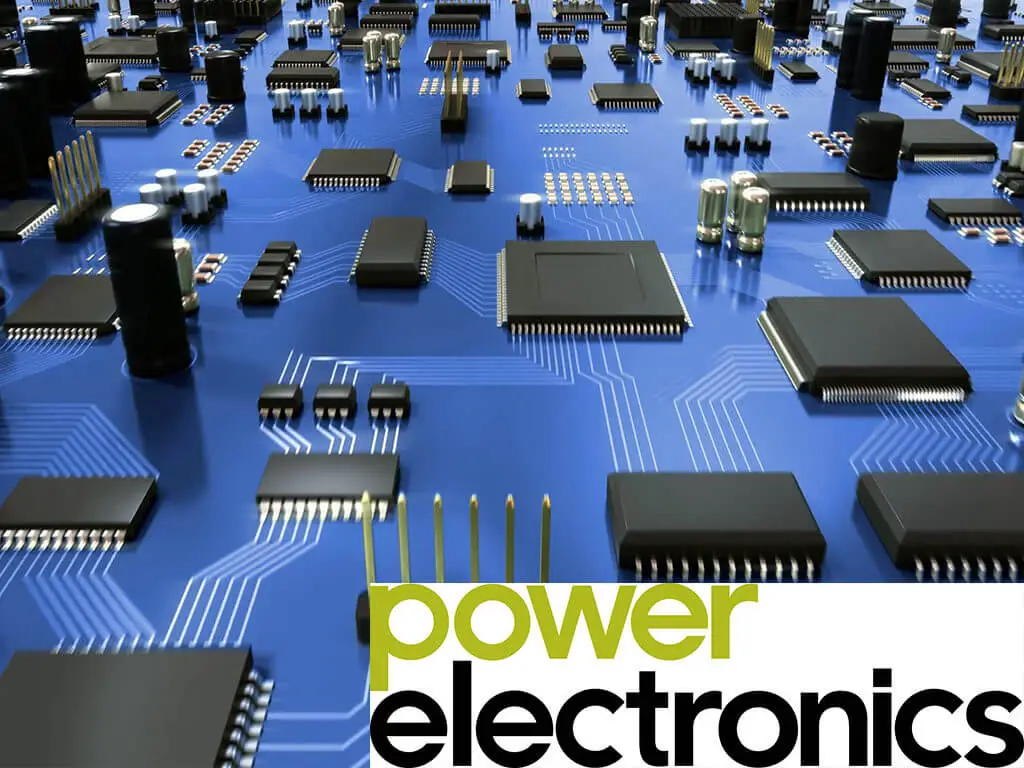
FAQs about Power Electronics PDF
What is power electronics?
Power electronics is a field of study focused on the conversion, control, and management of electrical power using semiconductor devices.
What are some common applications of power electronics?
Power electronics is used in renewable energy systems, motor drives, consumer electronics, industrial processes, and more.
Why is efficiency important in power electronics?
Efficiency is crucial in power electronics to minimize energy loss and ensure optimal system performance.
What are the challenges faced by power electronics?
Challenges include electromagnetic interference, thermal management, and the complexity of control algorithms.
How does power electronics contribute to renewable energy?
Power electronics enables efficient extraction of energy from renewable sources like solar and wind for integration into the power grid.





